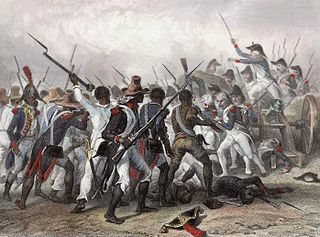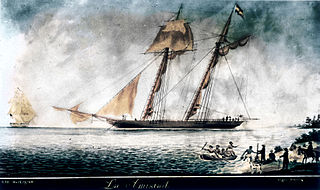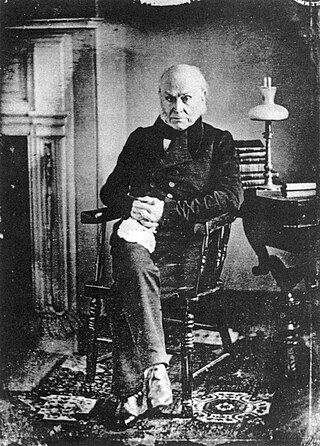
A slave rebellion is an armed uprising by enslaved people, as a way of fighting for their freedom. Rebellions of enslaved people have occurred in nearly all societies that practice slavery or have practiced slavery in the past. A desire for freedom and the dream of successful rebellion is often the greatest object of song, art, and culture amongst the enslaved population. Many of the events, however, are often violently opposed and suppressed by slaveholders.

United States v. Schooner Amistad, 40 U.S. 518 (1841), was a United States Supreme Court case resulting from the rebellion of Africans on board the Spanish schooner La Amistad in 1839. It was an unusual freedom suit that involved international diplomacy as well as United States law. The historian Samuel Eliot Morison described it in 1969 as the most important court case involving slavery before being eclipsed by that of Dred Scott in 1857.

James William Charles Pennington was an American historican, abolitionist, orator, minister, writer, and social organizer active globally. Pennington is the first known Black student to attend Yale University. He was ordained as a minister in the Congregational Church, later also serving in Presbyterian churches for congregations in Hartford, Connecticut; and New York. After the Civil War, he served congregations in Natchez, Mississippi; Portland, Maine; and Jacksonville, Florida.

Amistad is a 1997 American historical drama film directed by Steven Spielberg, based on the events in 1839 aboard the Spanish slave ship La Amistad, during which Mende tribesmen abducted for the slave trade managed to gain control of their captors' ship off the coast of Cuba, and the international legal battle that followed their capture by the Washington, a U.S. revenue cutter. The case was ultimately resolved by the U.S. Supreme Court in 1841.

Montauk Point State Park is a 862-acre (3.49 km2) state park located in the hamlet of Montauk, at the eastern tip of Long Island in the Town of East Hampton, Suffolk County, New York. Montauk Point is the easternmost extremity of the South Fork of Long Island, and thus also of New York State.

The coastwise slave trade existed along the eastern coastal areas of the United States in the antebellum years prior to 1861. Shiploads and boatloads of slaves in the domestic trade were transported from place to place on the waterways. Hundreds of vessels of various sizes and capacities were used to transport the slaves, generally from markets of the Upper South, where there was a surplus of slaves, to the Deep South, where the development of new cotton plantations created high demand for labor.

Josiah Willard Gibbs Sr. was an American linguist and theologian, who served as professor of sacred literature at Yale University. He is chiefly remembered today for his involvement in the Amistad case and as the father of theoretical physicist Josiah Willard Gibbs.

Sengbe Pieh, also known as Joseph Cinqué or Cinquez and sometimes referred to mononymously as Cinqué, was a West African man of the Mende people who led a revolt of many Africans on the Spanish slave ship La Amistad in July 1839. After the ship was taken into custody by the US Revenue-Marine, Cinqué and his fellow Africans were eventually tried for mutiny and killing officers on the ship, in a case known as United States v. The Amistad. This reached the U.S. Supreme Court, where Cinqué and his fellow Africans were found to have rightfully defended themselves from being enslaved through the illegal Atlantic slave trade and were released. The US government did not provide any aid to the acquitted Mende People. The United Missionary Society, a black group founded by James W.C. Pennington, helped raise money for the return of thirty-five of the survivors to Sierra Leone in 1842.
Tecora was a Portuguese slave ship of the early 19th century. The brig was built especially for the slave trade although the transport across the Atlantic of human beings as slaves had already been outlawed by several nations in international treaties in the first decade of the 19th century. She was fast and maneuverable in order to evade British patrols that attempted to stop such illegal slave ships off the coast of Africa.

La Amistad was a 19th-century two-masted schooner owned by a Spaniard colonizing Cuba. It became renowned in July 1839 for a slave revolt by Mende captives who had been captured and sold to European slave traders and illegally transported by a Portuguese ship from West Africa to Cuba, in violation of European treaties against the Atlantic slave trade. Spanish plantation owners Don José Ruiz and Don Pedro Montes bought 53 captives in Havana, Cuba, including four children, and were transporting them on the ship to their plantations near Puerto Príncipe. The revolt began after the schooner's cook jokingly told the slaves that they were to be "killed, salted, and cooked." Sengbe Pieh unshackled himself and the others on the third day and started the revolt. They took control of the ship, killing the captain and the cook. Three Africans were also killed in the melee.

James Benjamin Covey was a sailor, remembered today chiefly for his role as interpreter during the legal proceedings in the United States federal courts that followed the 1839 revolt aboard the Spanish slave ship La Amistad. Covey, who spoke Mende and English, was instrumental for enabling the Mende passengers of the Amistad to communicate with the court and to defend themselves successfully against charges of mutiny and murder.

Lewis Tappan was a New York abolitionist who worked to achieve freedom for the enslaved Africans aboard the Amistad. He was born in Northampton, Massachusetts, into a Calvinist household.
The Mendi Bible is a Bible presented to John Quincy Adams in 1841 by a group of freed Mendi captives who had mutinied on the schooner La Amistad.
Sierra Leonean Americans are an ethnic group of Americans of full or partial Sierra Leonean ancestry. This includes Sierra Leone Creoles whose ancestors were African American Black Loyalists freed after fighting on the side of the British during the American Revolutionary War. Some African Americans trace their roots to indigenous enslaved Sierra Leoneans exported to the United States between the 18th and early 19th century. In particular, the Gullah people of partial Sierra Leonean ancestry, fled their owners and settled in parts of South Carolina, Georgia, and the Sea Islands, where they still retain their cultural heritage. The first wave of Sierra Leoneans to the United States, after the slavery period, was after the Sierra Leone Civil War in the 1990s and early 2000s. According to the American Community Survey, there are 34,161 Sierra Leonean immigrants living in the United States.

Like most contemporaries, John Quincy Adams' views on slavery evolved over time. Historian David F. Ericson asks why he never became an abolitionist. He never joined the movement called "abolitionist" by historians—the one led by William Lloyd Garrison—because it demanded the immediate abolition of slavery and insisted it was a sin to enslave people. Further, abolitionism meant disunion and Adams was a staunch champion of American nationalism and union.
Simeon Jocelyn was an American minister, abolitionist and activist known for promoting educational opportunities and civil and political rights for African Americans in New Haven, Connecticut during the 19th century. He is also known for his attempt to establish the United States' first college for African Americans in New Haven, and for his role in the Amistad affair.

Inhuman Bondage: The Rise and Fall of Slavery in the New World is a book by American cultural and intellectual historian David Brion Davis, published by Oxford University Press in 2006. It recounts the history of slavery in a global context. It was praised widely as a full and comprehensive rendering of the subject and won the 2007 Ralph Waldo Emerson Award.

The Amistad Memorial in New Haven, Connecticut, is a bronze sculpture created by Ed Hamilton to recognize the events of the 1839 Amistad Affair. The affair was a kidnapping of 53 Africans and their subsequent mutiny aboard La Amistad. It led to a historically significant United States Supreme Court case, in which the Amistad captives were ruled to be acting in self-defense, thereby granting them the right to mutiny.















